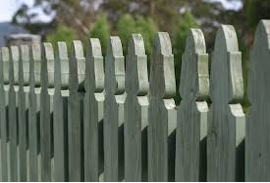Spring is just around the corner, and more likely than not, your fence is looking a little drab. If you”™re reaching for the paint bucket ”“ stop ”“ and read why staining your fence is actually the best way to go.
There are some benefits of choosing paint over stain. For instance, there is guaranteed to be a wider selection of paint colors than stain colors. Paint also provides a thicker barrier against the elements and can last for years. The downside is it will chip. Don”™t get stuck patching up the fence every few months, opt for a stain instead.
Unlike its painted counterpart, a stained fence will not chip. Stained fences offer a more rustic look than painted ones because the grain of the wood remains visible through the stain. Staining also requires fewer coats than painting does.
So how does one stain a fence, exactly?
The first step is choosing the correct stain. Take home a sample before committing to a particular stain Test it out on a small area of your fence, or piece of scrap wood first, to decide if it”™s the right color and type. Always use a waterproof stain when working with fences and anything that has to endure severe weather conditions.
Stain can be applied in a variety of ways. When staining a fence, rough surface paint rollers are the best choice. Before applying any stain, make sure that the fence is clean and completely dry. If the fence is weathered, treat it with a coat of bleach first; it kills the mildew spores, preventing them from spreading.
Staining also takes less time than painting. For starters, it doesn”™t require priming the wood. It also requires only one or two coats, depending on how dark you want the stain to appear. Stains will begin to fade after a few years, so keep that in mind when choosing a shade.
Familiarize yourself with the various stains available. Depending on the type of stain, the coverage will vary from very transparent to solid coverage. Here”™s what you need to know about the different stains available:
”¢ Oil stain ”“ Oil stain must be used to re-stain any surface that way previously oil stained. It can also be applied over latex stained surfaces.
”¢ Latex stain ”“ Better color retention, easy cleanup, and can be applied over wet surfaces.
”¢ Semitransparent stain ”“ usually used on fences and decks. Semitransparent stain accentuates the grain of the wood, and allows the wood”™s natural color to show through. Creates a rustic look. Color of the wood is an important factor choosing the color of your stain.
”¢ Solid stain ”“ Leaves a solid coating of pigment, similar to paint. Used when you don”™t want to see the color or grain of the wood. Solid stain tends to come off when it gets damp, so this type of staining is best on surfaces that wont be sat or walked on.
Make sure it”™s at least 50 degrees Fahrenheit when you stain, and don”™t begin your project if the weatherman is calling for rain in the next few days. The stain will need at least two days to dry completely. And for the sake of your skin and clothes, don”™t lean up against or touch that face until it”™s completely dry.
The next time you decide your fence needs some attention, swap the paint out for a stain. It offers an alternative look to the traditional white picket fence, and is easier to apply. Your fence will not only look marvelous, but it will also require much less maintenance over the years.
Not sure this is a project you’d like to take on yourself? Give us a call & we’ll handle it for you!


